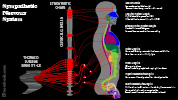Sympathetic Nervous System, Sympathetic System, Sympathetic Nerve
- See Also
- Definitions
- Sympathetic Nervous System
- Part of Autonomic Nervous System with activity that typically counters the Parasympathetic Nervous System
- Energy expending (catabolic) system, activated in stressful situations (e.g. emergency fight or flight)
- Contrast with the Parasympathetic Nervous System, an energy conserving system activated at times of rest
- Physiology
- Activity
- See Adrenergic Receptor
- See Alpha Adrenergic Receptor (alpha 1 and alpha 2)
- See Beta Adrenergic Receptor (beta 1 and beta 2)
- Increases Heart Rate (chronotropic), heart contraction strength (ionotropic), Blood Pressure
- Increases Respiratory Rate and bronchodilation
- Increases pupil size or Mydriasis (contrast with Miosis and accommodation by the Parasympathetic System)
- Stimulates Salivary VISCOUS secretion (contrast with watery secretion by Parasympathetic System)
- Stimulates sweat secretion (via Cholinergic postganglionic fibers)
- Decreases gastrointestinal activity and secretion, and contracts gastrointestinal sphincters
- Stimulates liver Gluconeogenesis and glycogenesis and fat lipolysis
- Stimulates Kidney renin release and Adrenal MedullaEpinephrine release (Cholinergic postganglionic fibers)
- Mediates ejaculation (contrast with Erection mediated by Parasympathetic System)
- Shunts Blood Flow to critical organs
- Anatomy
- Thoracolumbar division of the Autonomic Nervous System
- Signals originate in the spinal cord intermediolateral column (T1 to L2)
- Sympathetic Ganglionic chain extends from the foramen magnum to the low Sacrum
- Preganglionic nerves enter the paravertebral sympathetic Ganglionic chain
- Preganglionic nerves may traverse the chain several levels up or down before synapsing
- Preganglionic nerves Synapse at paravertebral or prevertebral ganglia
- Trigger postganglionic nerves via NeurotransmitterAcetylcholine
- Postganglionic Neuron (autonomic Ganglion to target organ)
- Norepinephrine mediated (with exceptions, such as Acetylcholine for sweating)
- Contrast with parasympathetic postganglionic fibers which release Acetylcholine
- Images
- Pathophysiology
- References
- Goldberg (2014) Clinical Neuroanatomy, Medmaster, p. 54-60
- Netter (1997) Atlas Human Anatomy, ICON Learning, p. 152-4

